
A more equal distribution of parental leave is one of the most important ways to increase equality between men and women in Finnish working life. The parental leave reform that came into force in August 2022 improved access to longer leave also for non-birthing parents, such as fathers.
However, attitudes and practices in the workplace still greatly influence parents’ willingness and ability to go on parental leave. TEK (Academic Engineers and Architects in Finland) looked into its members’ views and experiences regarding family leave in October-November 2023 as part of its annual Labour Market Survey. This article presents key findings from the survey.
Parents with young children are familiar with the family leave reform
42 percent of all respondents were familiar with the family leave reform (Figure 1). However, knowledge of the reform varied considerably depending on the age of the respondent’s youngest child, which is quite understandable. While nearly all (97%) parents of children under 1 years of age said that they were familiar with the reform, only one in three (33%) of respondents without children said the same. Just over a third (35%) of parents whose youngest child was of school age or older said that they were aware of the reform.
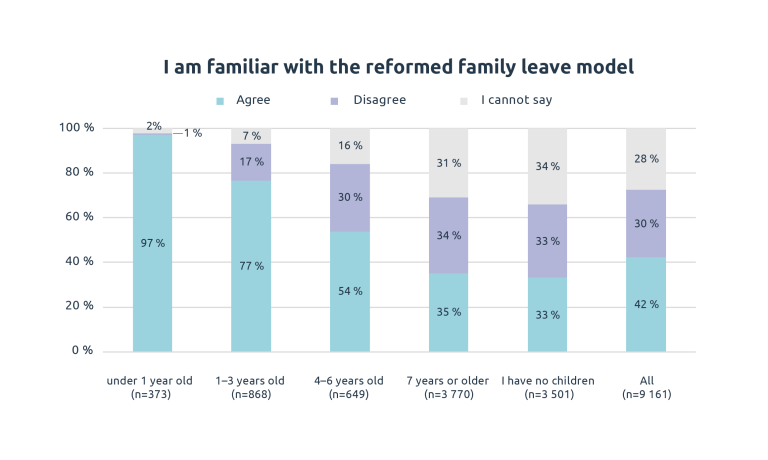
In the open responses, respondents were positive about the reform. Examples from the comments:
- As a non-birthing parent, I’m happy with the increased number of family leave days when compared to the previous model. The increase in paid leave days is also nice, but it did not influence my decision to go on family leave. (Male, youngest child 0–3 years)
- It’s great that the family leave reform encourages a more equal sharing of caring responsibilities between parents. My employer hoped that I, as the birthing parent, would use my family leave uninterruptedly. This led to me taking about 8 months of pregnancy + child care leave, after which my spouse stayed home for 6 months. (Female, youngest child 0–3 years)
- It’s wonderful and more equal that I, as a father, can also stay at home with the child for longer. (Male, youngest child 0–3 years)
Two out of three respondents (67%) could not say whether their workplace offers paid family leave, with only 28% of all respondents saying “yes” and 5% saying “no” (Figure 2). 75% of parents of children under 1 year of age said that their place of work offers paid family leave, whereas just over half (54%) of parents of children aged 1–3 said the same. The majority (79%) of respondents without children could not answer the question.
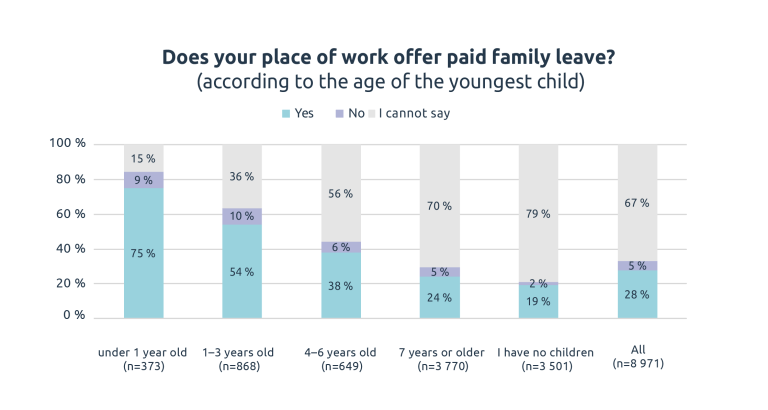
Employers support the reconciliation of work and family life, but there is uncertainty about taking different family structures into account
The vast majority of respondents (80%) said that their employer offers sufficient support for reconciling work and family life (Figure 3). Just under half of the respondents said that their employer takes a positive stance on reduced working hours, such as part-time child-care leave. However, nearly 40% of respondents could not form an opinion on the matter. Even fewer respondents could estimate whether their employer takes different family structures sufficiently into account. One in three answered “yes” to this question, but 64% answered “I cannot say.”
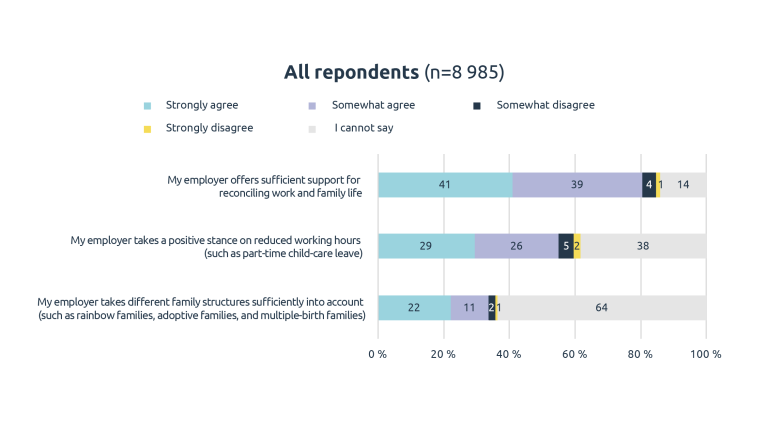
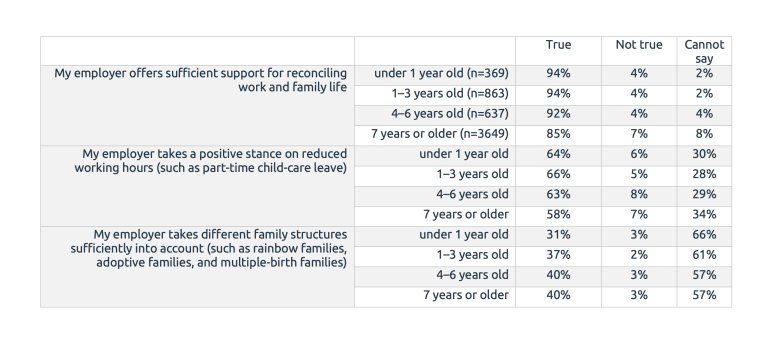
We were happy to see that more than 90% of parents of children under school age think that their employer offers sufficient support for reconciling work and family life (Table 1). Only 4% of parents of young children disagree with the statement. In addition, two out of three parents of children under school age think that their employer takes a positive stance on reduced working hours.
In the open comments, respondents described the situation as follows:
- The employer’s attitude has been excellent, and there has been no pressure to take fewer leave days or not take them at all. (Male, youngest child 0–3 years)
- The general attitude towards new babies being born has been positive. My supervisors having several children of their own has helped matters. (Male, youngest child 0–3 years)
- I changed jobs because of pregnancy discrimination, and my new employer offered more flexibility when it comes to reconciling work and family life. (Female, youngest child 0–3 years)
It is somewhat surprising that parents of young children are as uncertain as other respondents when it comes to taking different family structures into account. For example, just under a third (31%) of parents of children under one year of age believe that their employer takes different family structures sufficiently into account. Three percent of respondents disagree with this statement, and the majority (66%) cannot say.
Workplace attitudes towards family leave are mostly positive
The majority of respondents (65%) believe that their employer takes a positive stance on the use of parental leave by birthing parents, although a third of respondents answered “I cannot say” (Figure 4). Nearly as many (60%) believe that their employer takes a positive stance on the use of family leave by non-birthing parents. However, 37% of respondents answered “I cannot say.” Furthermore, 60% of respondents believed that their workplace makes it easy also for non-birthing parents (such as the father) to take family leave.
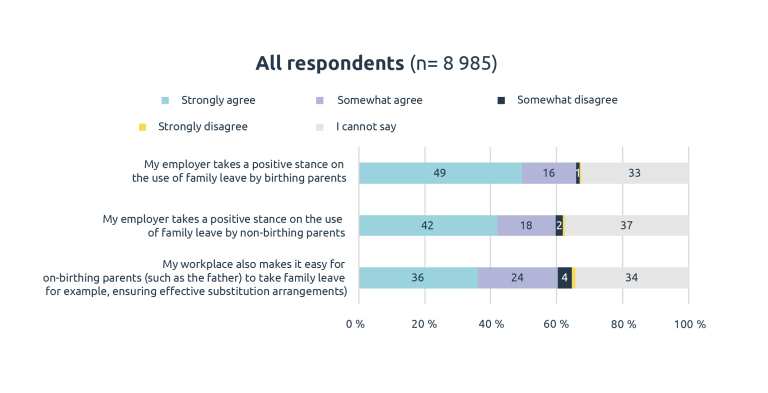
Parents of young children are more likely to believe that their employer takes a positive stance on the use of family leave (Table 2). Around 80% of parents of children under school age say that their employer takes a positive stance on the use of family leave by birthing parents. Even more respondents think that their employer takes a positive stance on the use of family leave by non-birthing parents. For example, as much as 87% of parents of children under 1 year of age agree with the statement, and only 9% answered “I cannot say.” However, the proportion of those who answered “I cannot say” increases significantly as the age of the youngest child increases.
In the open comments, respondents said the following:
- The news of a baby being born was welcomed at work, and going on family leave was easy. For example, I was invited to our office pre-Christmas party when I was on family leave, and I visited the workplace a few times with my baby to see my colleagues. (Female, youngest child 0–3 years)
- I was on family leave for three weeks after the baby was born, and I’m going to take about five months of leave next spring to take care of the baby. I’m really looking forward to it! My employer thinks that it goes without saying that parental leave should be taken in full. (Male, youngest child 0–3 years)
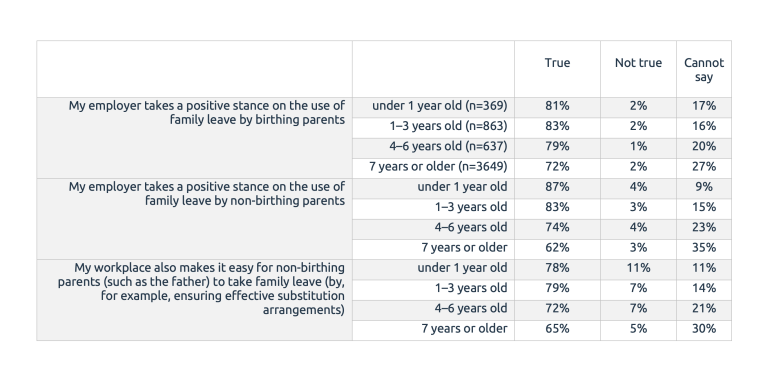
On the other hand, it is somewhat worrying that the parents of very young children often think that it is not easy for non-birthing parents to take family leave. In the open comments, respondents raised issues such as challenges in substitution arrangements, which may also affect birthing parents. In addition, the attitudes of employers and supervisors towards family leave may vary between birthing and non-birthing parents.
- I feel that my employer seemingly supports family leave, but the practical handling of the matter is entirely dependent on the supervisor in question. There was no one to fill in for me when I started my family leave, and I couldn’t even take as much time off as I would have liked, because no one would have taken care of my project during my absence. (Male, youngest child 0–3 years)
- As I am a woman, no one questioned my maternity or family leave. However, one person in a supervisory position (not my supervisor) said that men don’t need to take any family leave at all, as being home in the evenings and on weekends is enough to build a relationship with the child. I was shocked by their attitude. (Female, youngest child 0–3 years)
- I’m about to go on family leave, but it seems like my employer is not going to hire a replacement for me. This has caused stress both for myself and my work community. (Female, youngest child 0–3 years)
Employees may also see the use of family leave as a threat to their career development
Of all respondents, 12% believed that the use of family leave would have a negative impact on their career development while working for their current employer (Figure 5). Just over half of respondents (53%) disagreed with this statement, while 35% answered “I cannot say.” Assessing the negative effects of family leave was most difficult for respondents without children, which is to be expected.
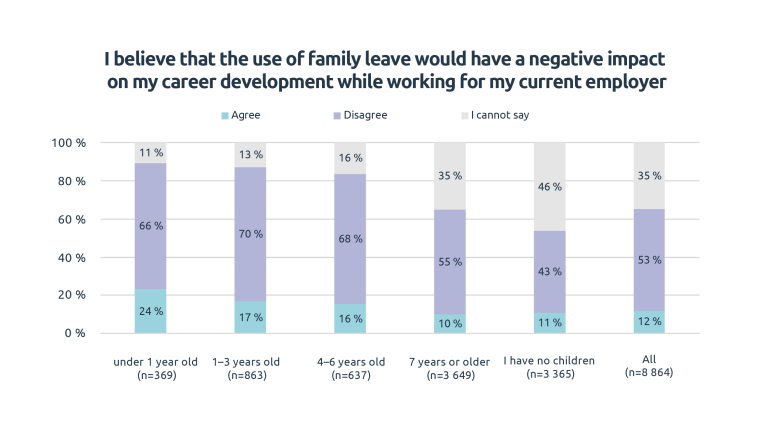
Quite worryingly, one in four (24%) parents of children under the age of 1 believe that the use of family leave would have a negative impact on their career development. Although two in three (66%) parents of very young children disagree with this statement, the proportion of those who agree with it is significant. If we take the gender of the respondents into account, we can see that 22% of men and 29% of women believe that the use of family leave would have a negative impact on their career development (Table 3).
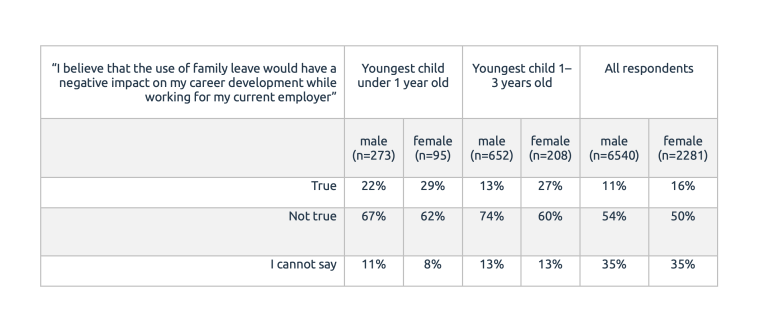
In the open comments, respondents said the following:
- My supervisor is American (remote supervisor), and I work in a global business team. The work community is very goal-oriented, and I don’t think that my supervisor would have any sympathy for the Nordic family leave model if I decided to stay at home while my wife goes to work when our child is under one year old. I haven’t yet decided whether to take this opportunity or not. (Male, youngest child 0–3 years)
- People say that they feel positive about family leave, but you can never tell if they are being honest or not. Employment benefits, bonuses, etc. during family leave are a complete mystery, and unpleasant surprises always come up. The supervisors know nothing about family leave, and the HR department’s answers are pretty much just “f... you.” (Male, youngest child 0–3 years)
- All discussions about promotion and career development ended the moment I said that I was going on family leave. (Female, youngest child 0–3 years)
In conclusion
Respondents said that, overall, their return to work after family leave went well. Returning to work from parental leave had a greater impact on the employment of women than men, which is quite understandable, as women’s family leaves tend to be longer. 23% of women said that the terms of their employment improved after family leave. The corresponding figure for men was 6%. In addition, 15% of women (4% of men) said that they moved to a more demanding role with the same employer or a different one after the leave.
Women in particular have also seen family leave as an opportunity to reflect on what they want from their careers. This may also lead to changing jobs. Some examples of comments from respondents:
- At my previous employer, the new manager hired during my maternity leave ignored me in the organizational change. I felt this was very unfair, and I applied for a new job already before coming back from my maternity leave. Fortunately, the new workplace is much better, and I am very happy with my current situation. (Female, youngest child 0–3 years)
- Family leave also works as a breather from my rather exhausting working life and an opportunity to distance myself from my own work and think about what I would like to do next in terms of my career. Employers should also see this as a positive thing and encourage employees to make changes to their career paths also during/after family leave. (Female, youngest child 0–3 years)
- I changed jobs quite soon after my family leave, as it gave me time to think about what I really wanted to do. (Female, youngest child 0–3 years)
How this study was carried out
The data for the study was collected from TEK’s (Academic Engineers and Architects in Finland) survey on family leave, which was conducted as part of the annual Labour Market Survey. The data was collected through an online survey in October-November 2023. The target group was members of TEK who are active in working life. The response rate was 21%. Approximately 9,000 people answered the questions concerning family leave.
The aim of the study was to examine TEK members’:
- attitudes toward the use of family leave,
- familiarity with the reformed family leave model (2022),
- the current situation regarding the use of family leave, and
- possible changes compared to the previous study (2018).
The study can help raise awareness among TEK members about family leave and encourage them towards a more equal sharing of family leave between parents. The results will also be used in collective bargaining and to support staff representatives. The study also supports the implementation of TEK’s council agreement.
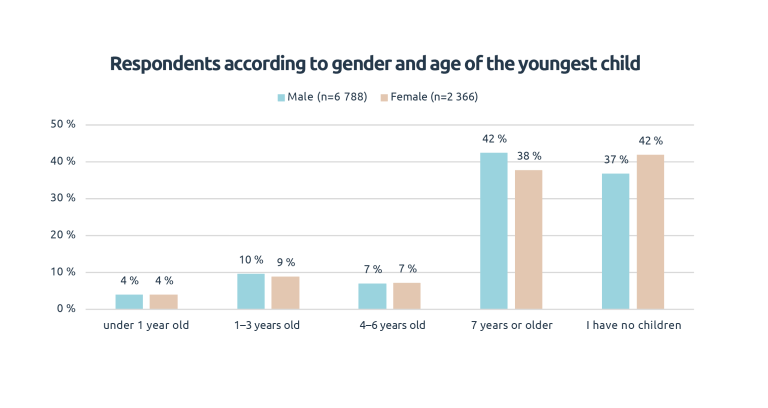
This article uses descriptive methods (frequencies, cross-tabulations).
TEK Hour: Family - to leave or not to leave
In this TEK Hour, you'll get acquainted with the parental leave system in Finland and the payment during parental leaves. You'll also hear the latest research findings on parental leaves.
The session will be held as a Teams webinar and will last for an hour. You'll have the opportunity to ask questions via chat and the experts will answer them at the end of the presentation. Welcome aboard!
- Date: 6.6.2024
- Time: 8:30–9:30
What topics does TEK study?
We at TEK are constantly researching the field of technology: employment, salaries, equality, and coping with work or studies, for example. We have studied and published information on many themes for years – you are welcome to examine and compare the results using, for example, time series visualizations. Read more about our research: www.tek.fi/research